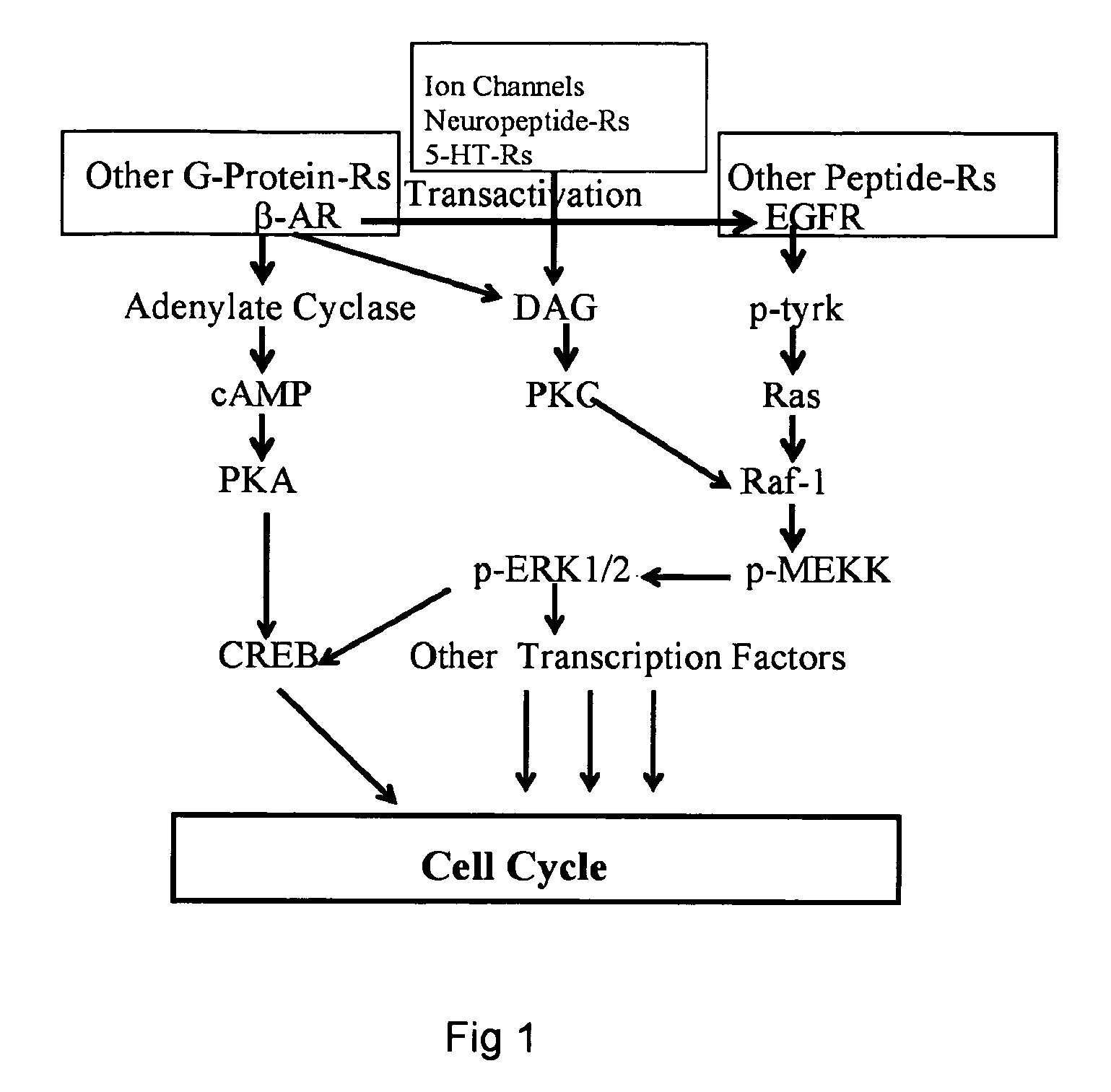Diagnosis by determination of hyperactivity or increased expression of members of cell signaling pathways
a cell signaling pathway and hyperactivity technology, applied in the field of disease diagnosis, can solve the problems of clinical results disappointing, uncontrolled growth or division of cells, and the inability to use tests as a general screening for cancer in patients
- Summary
- Abstract
- Description
- Claims
- Application Information
AI Technical Summary
Problems solved by technology
Method used
Image
Examples
example 1
[0050] Syrian Golden Hamsters are injected subcutaneously with the tobacco-specific carcinogenic nitrosamine 4-(methylnitrosamino)-1-(3-pyridyl)-1-butanone (NNK) at a dosage of 2.5 mg / 100 g bodyweight three times weekly for 10 weeks. NNK has been shown to induce cancers of various organs, including lung, pancreas, and liver. Control hamsters are untreated. One week after the final NNK injection, approximately 250 microliters of venous blood is collected from the hamsters.
example 2
[0051] Antibodies that bind to phosphorylated or unphosphorylated members of the MAPK and GPCR pathways, including Raf, Ras, MEK, ERK, adenylate cyclase, cAMP, PKA, CREB, and PKC are purchased from commercial sources, including EMD Biosciences (San Diego, Calif.) (Raf, ERK), BD Biosciences Pharmingen (San Diego, Calif.) (Raf), Cell Signaling Technology (Beverly, Mass.) (Ras), Abgent (San Diego, Calif.) (MERK), GenWay Biotech Inc. (San Diego, Calif.) (adenylate cyclase), Abcam, Inc. (Cambridge, Mass.) (cAMP, PKA, PKC, Raf), and Upstate (Charlottesville, Va.) (CREB).
[0052] Paired antibodies for each of the above member of the MAPK and GPCR pathways are utilized as coating antibody and detection antibody in formulating an ELISA (Enzyme-Linked Immunosorbent Assay) for each of the members. ELISA tests for each of the pathway members are developed using the ENDOGEN® ELISA Development Kit from Pierce Biotechnology Inc.
[0053] Briefly, a first antibody that binds to a member of the MAPK or...
example 3
[0055] Radiohalogenated analogues of BAY 43-9006, an inhibitor of the Raf protein, suitable for use as tracers in PET or SPECT imaging, are produced. The structure of BAY 43-9006 is shown below as Formula 1. Table 1 shows the radiohalogenated analogues of BAY 43-9006, compounds 1a to 1h, that are produced.
TABLE 1Radiohalogenated BAY 43-9006 Analogues1a: W = 18F; X = H; Y = H; Z = H1b: W = Cl; X = 18F; Y = H; Z = H1c: W = Cl; X = H; Y = 18F; Z = H1d: W = Cl; X = H; Y = H; Z = 18F1e: W = 124I; X = H; Y = H; Z = H1f: W = Cl; X = 124I; Y = H; Z = H1g: W = Cl; X = H; Y = 124I; Z = H1h: W = Cl; X = H; Y = H; Z = 124I
[0056] The overall synthetic scheme for preparing the BAY 43-9006 analogues is based on the efficient coupling of labeled bis aryl ethers with anilines utilizing the carbonydiimidazole (CDI) chemistry as shown below in Scheme 1. This coupling reaction is facile, high yield, and tolerates a variety of functional substituents.
Scheme 1—General Reaction for the Formation of b...
PUM
 Login to View More
Login to View More Abstract
Description
Claims
Application Information
 Login to View More
Login to View More - R&D
- Intellectual Property
- Life Sciences
- Materials
- Tech Scout
- Unparalleled Data Quality
- Higher Quality Content
- 60% Fewer Hallucinations
Browse by: Latest US Patents, China's latest patents, Technical Efficacy Thesaurus, Application Domain, Technology Topic, Popular Technical Reports.
© 2025 PatSnap. All rights reserved.Legal|Privacy policy|Modern Slavery Act Transparency Statement|Sitemap|About US| Contact US: help@patsnap.com



